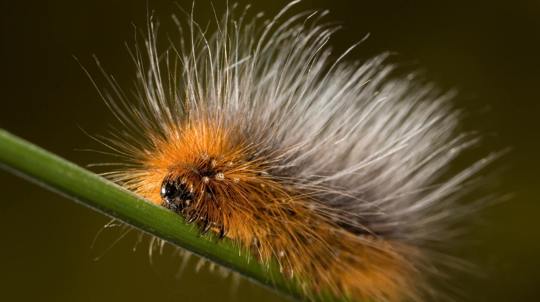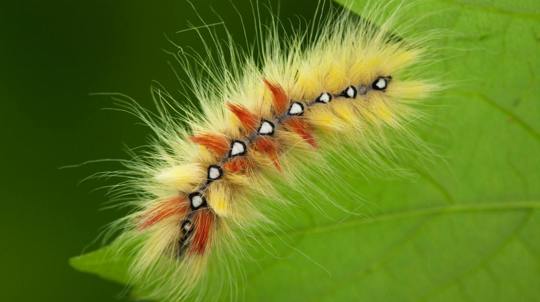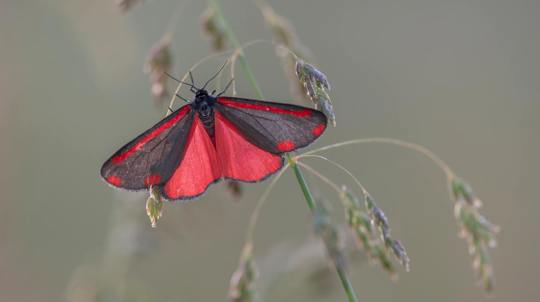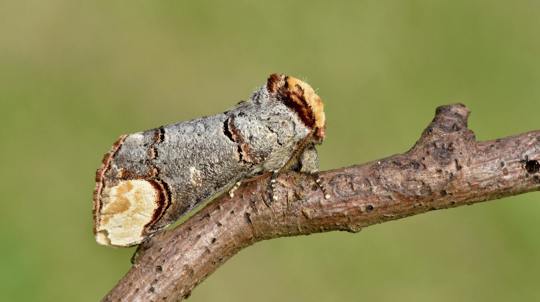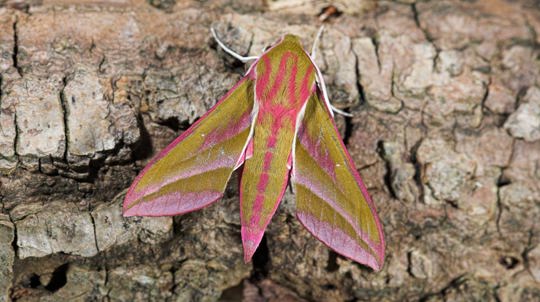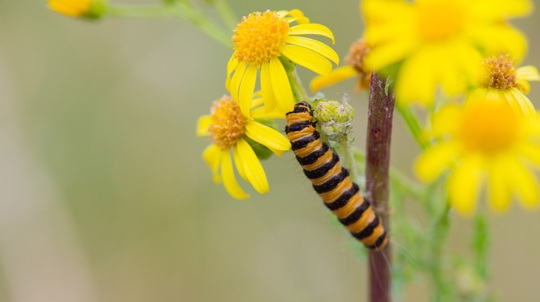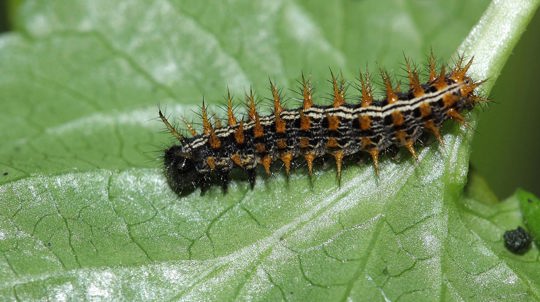They may look like stingers, but the horns on hawk-moth caterpillar tails are actually soft and harmless. It's thought they could act as a decoy for hungry predators, protecting the head end from attack, but no one is really sure.
Hawk-moth caterpillar identification: eight UK species

Content manager
Hawk-moth caterpillars have one thing in common: they're pretty impressive. Usually large, distinctively marked and with a characteristic 'horn' at the tail end, they're a good group to get to grips with when learning who's who. Which of these commonly encountered species have you spotted?
1. Elephant hawk-moth caterpillar (Deilephila elpenor)
How to identify
A thick, brown caterpillar with a small, stubby horn at the tail. The elephant hawk-moth gets its name from the trunk-like head which retracts and extends from its bulbous neck. When threatened it swells its neck, making its four large eye spots more prominent. Some forms can be bright green.
Size
Up to 80mm in length when fully grown.
When to see it
July - September. Often spotted in late summer undulating across paths in search of somewhere to pupate.
Where to find it
Common and widespread across much of the UK, although less frequent in Scotland and the north of England. Its range is however expanding. Found in almost all habitats, including woodlands, hedgerows and gardens.
Caterpillar foodplants
Willowherbs, fuchsias, Himalayan balsam, bedstraws and enchanter's nightshade.
2. Small elephant hawk-moth caterpillar (Deilephila porcellus)
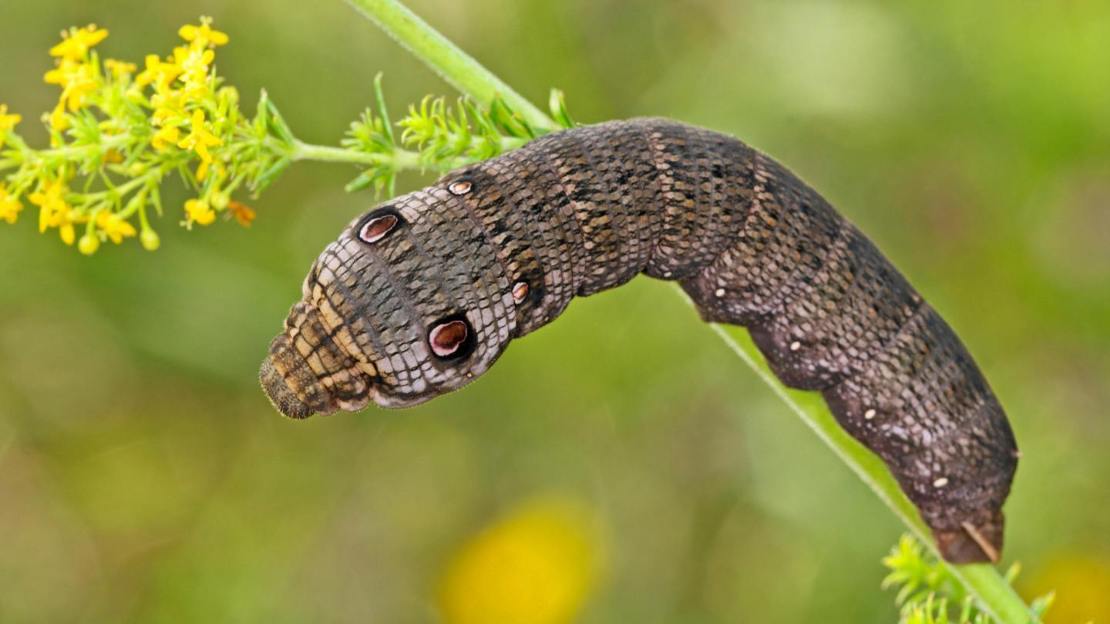
How to identify
Similar at first glance to its larger cousin (above) but lacking the tail horn of other hawk-moths. The eye spots have reddish centres and the second set are much smaller than the first.
Size
Up to 60mm in length when fully grown.
When to see it
July - September.
Where to find it
Most common across England and Wales, becoming more scarce north of the Humber and in Northern Ireland. Found mainly in grassy habitats, heathland and sometimes gardens.
Caterpillar foodplants
Mainly bedstraws but sometimes also rosebay willowherb.
3. Poplar hawk-moth caterpillar (Laothoe populi)
How to identify
The poplar hawk-moth has a light green or yellowish-green caterpillar covered in dense yellow speckles. Look for pale yellow stripes that cut diagonally across the body and a yellow tail horn. Some forms also have pinkish-red splotches along the body.
Size
Up to 70mm in length when fully grown.
When to see it
July - September.
Where to find it
Thought to be our commonest hawk-moth. Widespread across the UK in most habitats including woodlands, parks and gardens.
Caterpillar foodplants
4. Privet hawk-moth caterpillar (Sphinx ligustri)
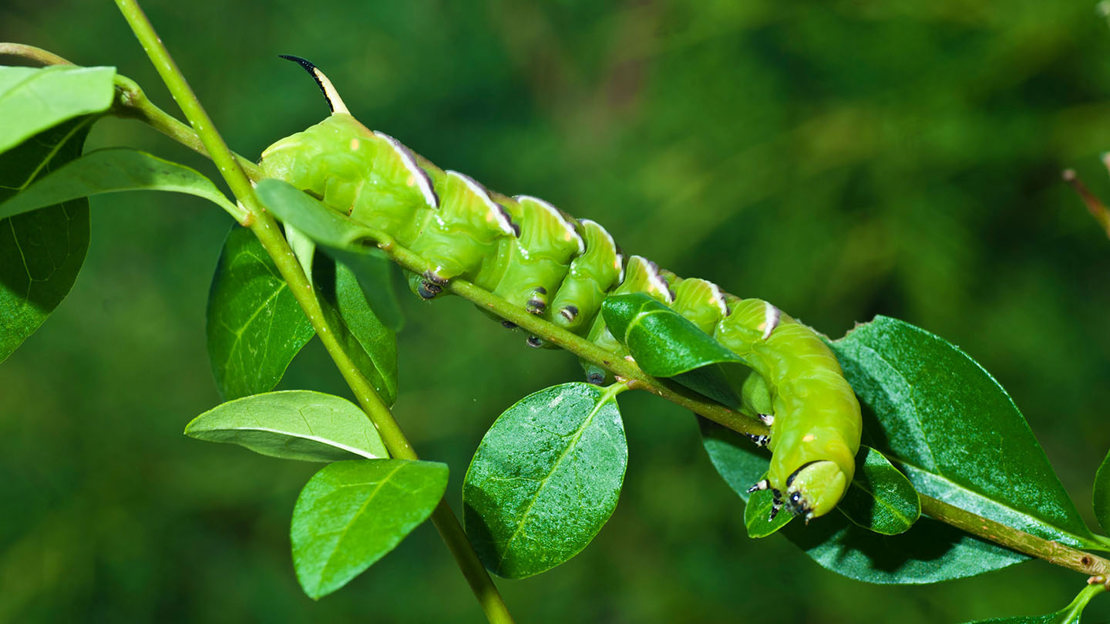
How to identify
This hefty chap is pretty unmistakable. The privet hawk-moth caterpillar has a bright green body with distinctive white and purple diagonal stripes. The large tail horn is curved and black-tipped. Also look for the dark ring around the head.
Size
Up to 85mm in length when fully grown.
When to see it
June - August.
Where to find it
Common across the south of England, parts of Wales and East Anglia, becoming scarce further north. Absent from Northern Ireland and Scotland. Found in a number of habitats including woodland, hedgerows, parks and gardens.
Caterpillar foodplants
Mainly feeds on privet but also ash, lilac, honeysuckle, holly, guelder rose and some garden plants.
Want to brush up on your ID skills?
Take a look at our range of wildlife swatch books for help with birds, butterflies and more.
Shop now5. Lime hawk-moth caterpillar (Mimas tiliae)
How to identify
Appears similar to the poplar hawk-moth at first glance but can be told apart by the tail horn, which is blue on top and often red and yellow underneath. Once mature and ready to pupate the body turns a darker, greyish-pink colour.
Size
Up to 65mm in length when fully grown.
When to see it
July - September. Often encountered on the ground in later summer when searching for somewhere to pupate.
Where to find it
Common across most of England and Wales south of the Humber but absent from Scotland and Northern Ireland. Found in woodland, parks and gardens as well as on street trees in urban areas.
Caterpillar foodplants
Limes (as the name suggests) but also a range of other deciduous trees including birch, elm, alder and London plane.
6. Eyed hawk-moth caterpillar (Smerinthus ocellata)
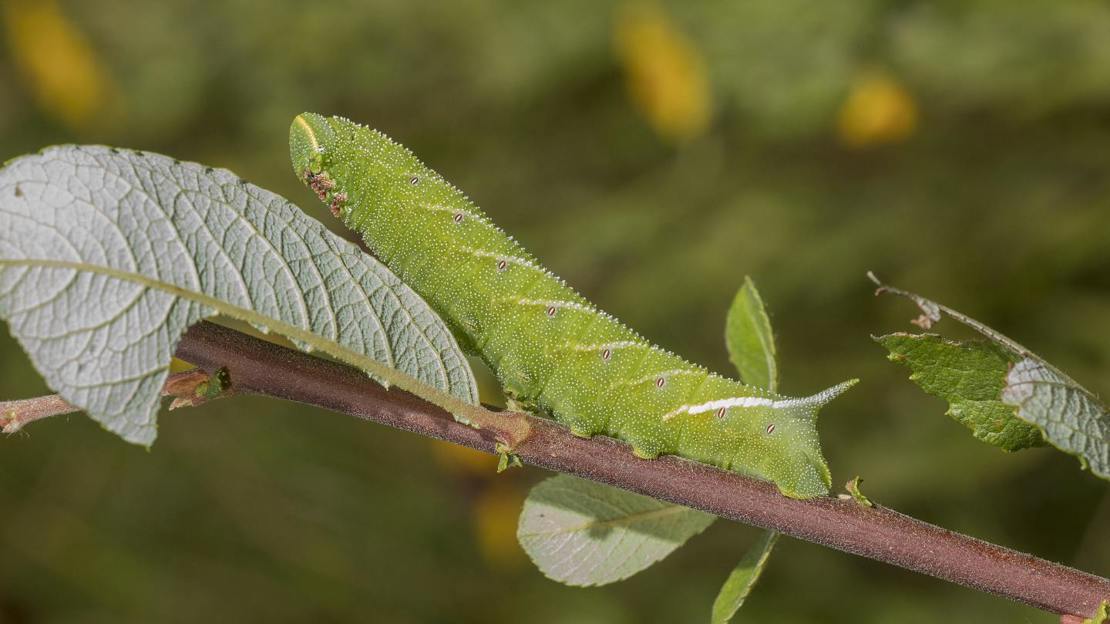
How to identify
A green caterpillar with a blue-ish tail horn when mature. Can be told apart from the lime hawk-moth caterpillar (above) by its white diagonal stripes along the body. Look also for the bright yellow collar bordering the flat, triangular head.
Size
Up to 75mm in length when fully grown.
When to see it
June - September.
Where to find it
Common and widespread across England and Wales, becoming more scarce in Northern Ireland. Mostly absent from Scotland. Found in woodland, orchards, parks, gardens and riverside habitats where willows are found.
Caterpillar foodplants
Mainly willows, sallows and apples but also aspen and poplar.
7. Pine hawk-moth caterpillar (Sphinx pinastri)
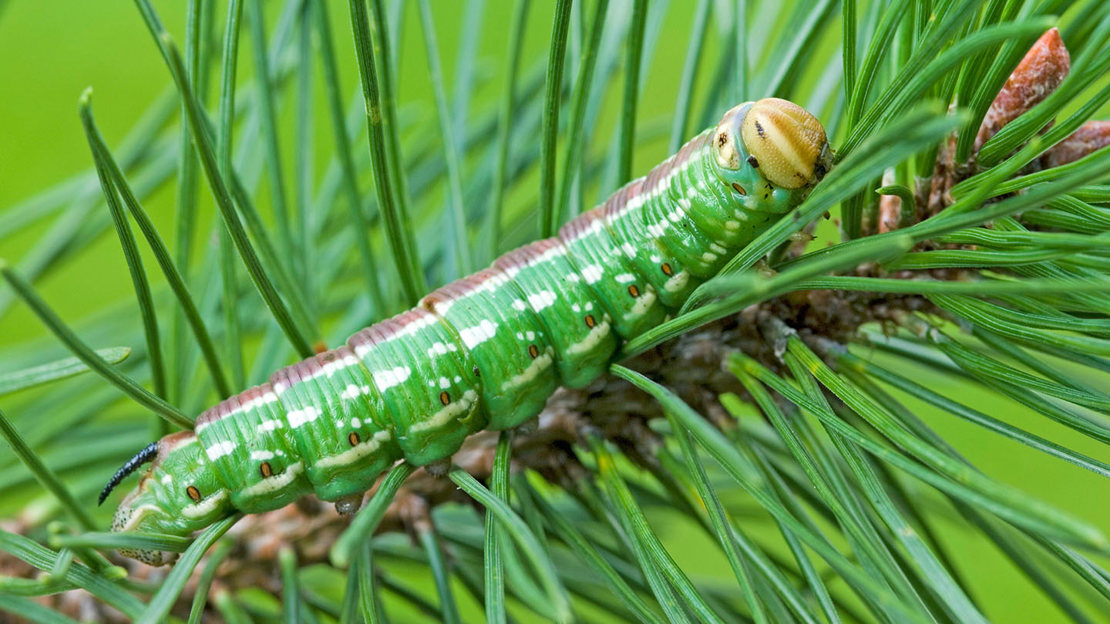
How to identify
When mature the pine hawk-moth caterpillar has a dark green body with a brown stripe along the back and broken creamy lines along its sides. The head is also brown and the tail horn black.
Size
Up to 80mm in length when fully grown.
When to see it
July - September.
Where to find it
Most common in south east England and East Anglia, becoming more scarce in central England. Mostly absent from Wales, Scotland and Northern Ireland. Found in coniferous woodland, heathland and sometimes gardens.
Caterpillar foodplants
Mostly feeds on the more mature needles of Scots pine, but occasionally other pines and spruces.
8. Hummingbird hawk-moth caterpillar (Macroglossum stellatarum)
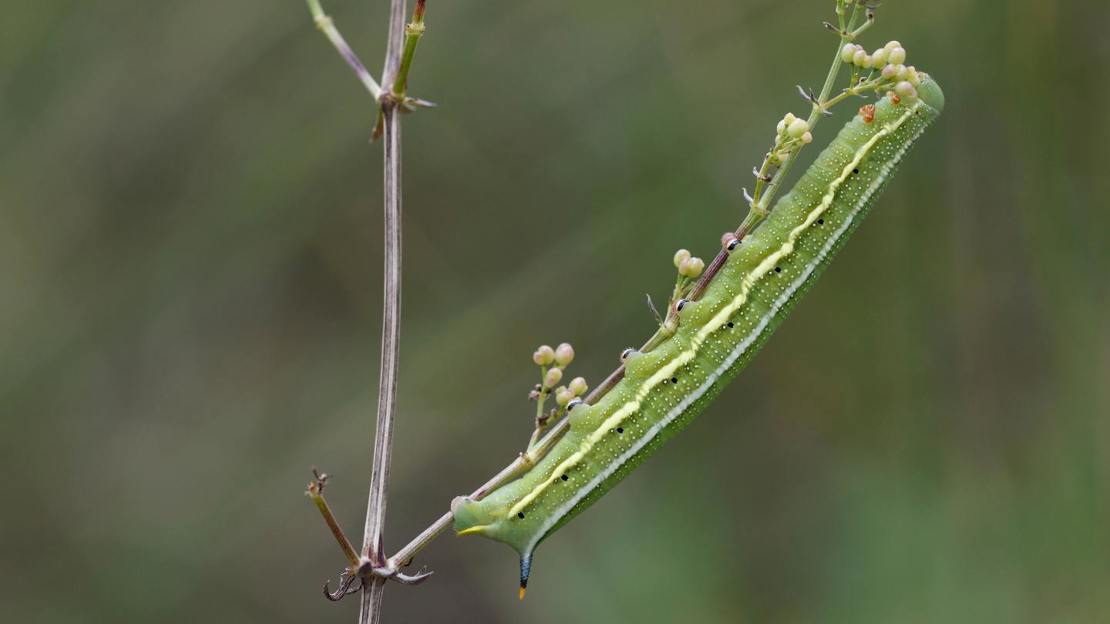
Hummingbird hawk-moths are not able to survive our cold winters. New arrivals each summer keep the UK population topped up.
How to identify
Mostly green with with a thick, creamy yellow stripe along the side and a white line above. The tail horn is black and yellow tipped when mature.
Size
Up to 55mm in length when fully grown.
When to see it
Mainly encountered in July and August.
Where to find it
Adult hummingbird hawk-moths are summer migrants to the UK and can be encountered almost anywhere. Look for their caterpillars where their favourite foodplants are found.
Caterpillar foodplants
Bedstraws and wild madder.
Create a wildlife haven in your garden
Help support pretty pollinating insects like butterflies and moths with garden trees rich in nectar and leafy forage.
Buy treesLearn more about moths and caterpillars


UK hawk-moth identification and facts
Amy Lewis • 21 Jun 2021
Hawk-moths are some of the largest and most recognisable moths in the UK. Learn to tell which is which with our visual guide to 10 of the most commonly encountered UK species.








